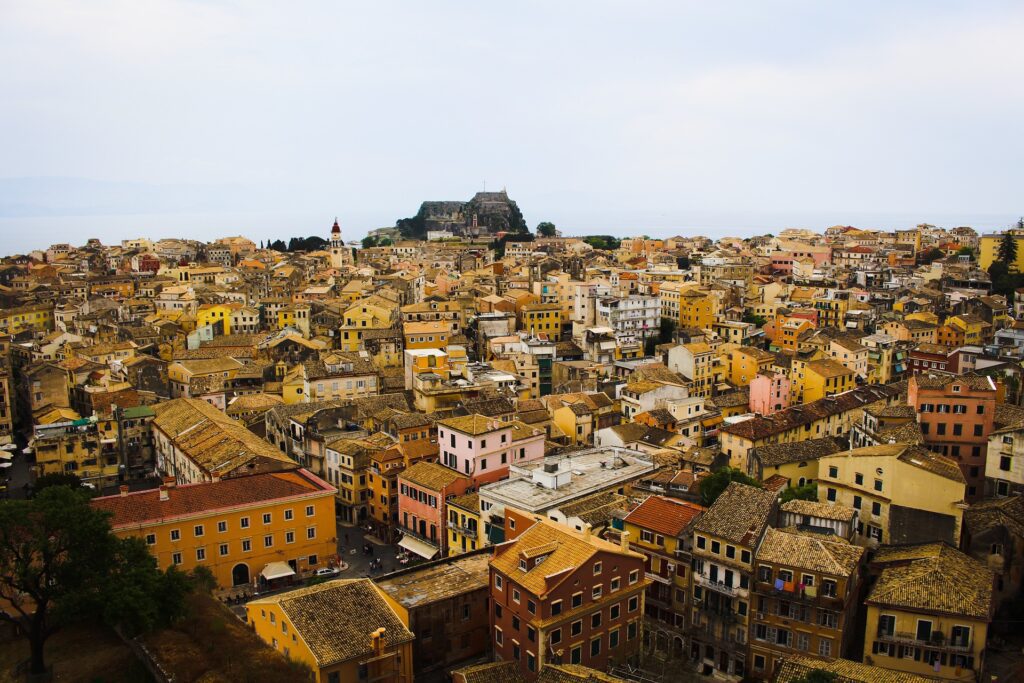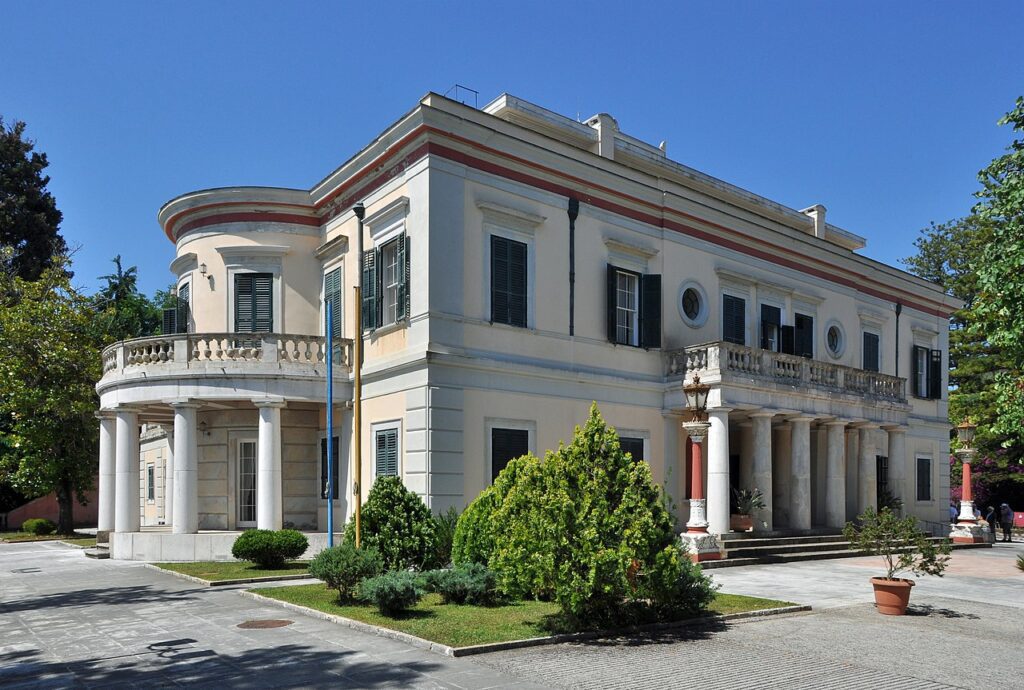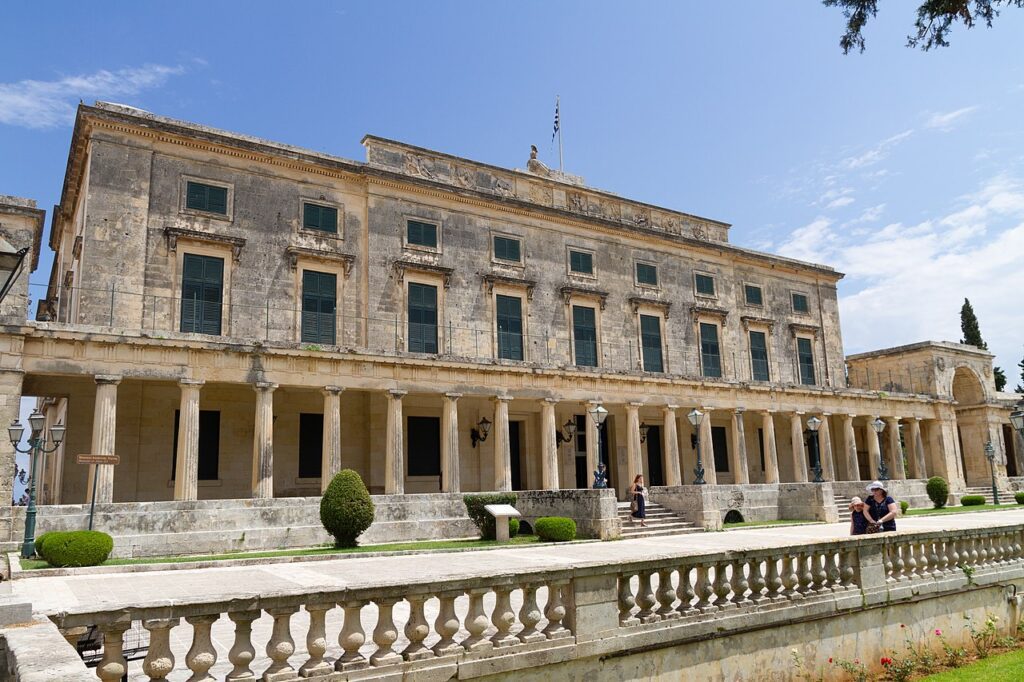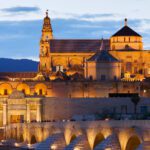Corfu Travel Guide
Introduction
Corfu Greece is one of the most beautiful and romantic islands of the Ionian island group. From lush green hills to noble mansions and from idyllic Corfu beaches, to interesting museums, this island has everything it takes to please any type of traveler. Strongly influenced by the Venetians, the French and the English, Corfu Town is a brilliant base for exploration. Get lost in the narrow cobblestone alleys, the so-called “kandounia”, visit museums, such as the Museum of Asian Art, walk down the famous Liston promenade, stroll around the huge Spianada square… The whole Corfu town squeezes out a nostalgic charm! You’ll see the glorious past of Corfu on imposing palaces, noble mansions, beautiful museums, and charming squares. Moving away from Corfu Town, you’ll discover picturesque seaside villages, tiny verdant islets, luxurious Corfu resorts, and wild natural landscapes. It’s amazing how the different sides of this idyllic island coexist in harmony!
If you manage to peel yourself away from the enchanting Corfu Town, move to the coasts of Corfu, where beautiful Corfu beaches are nestled! The beaches in Dassia, Paleokastritsa, Glyfada, Kontokali, and Kavos are must-visits. Nestled in sandy coves, surrounded by green forests and mountains, they are some of the best beaches in Greece! As for sightseeing, it’s one of the best things to do in Corfu! The top places to visit in Corfu are Achillion Palace, the former retreat of princess Sissi of Austria, Mon Repos palace, where Phillip, the husband of Queen Elizabeth II was born, the iconic Panagia Vlacherna and Pontikonisi island. They will make you fall even deeper in love with Corfu! Corfu Greece is famous for one thing in particular: it’s food! Based on meat, fish, pasta, and herbs, the island’s gastronomy will excite those who love good food. The excellent Corfu restaurants and traditional taverns are the best places to taste the local delicacies!
Corfu is waiting for you!

What’s the wibe?
The colors on Corfu are something else – from the aquamarines and emeralds of its seas, the dense inland evergreens, to the soft pinks and ochres of its weathered buildings which are echoed in the sunsets. The beauty of the island is not confined to one part, and resorts are spread out around the island. But broadly speaking, the north of the island is more hilly and craggy with lots of little bays. The pretty stretch between Nissaki and Kassiopi is popular with wealthy Brits and Russians who like to hide away in discrete villas in the hills. Safe sandy beaches attract package holidaymakers and families, particularly in the cheap and cheerful resorts that spread out along the coast in either direction from Corfu Town.

Corfu’s key strategic position – close to the mainland but controlling access to the Adriatic Sea – has ensured a rich and colourful history. Its Byzantine fortresses and are evidence of centuries of struggle against attacks. The legacy you see here is many Venetian and British – with a touch of French and Russian thrown in for good measure. Nowhere else in Greece will you find a cricket lawn and ginger beer. Knarly olive trees dominate the landscape – thanks to a Venetian policy that encouraged its cultivation. Corfu Town is a historical gem but also an administrative hub and home to the Ionian University, which keeps it lively even in the low season (in comparison to other island destinations, at least). Acharavi and Lefkimmi are two alternative options for winter. The downside of its popularity is that the coastal regions aren’t exactly undiscovered – head to the mountainous interior if you want to escape tourism altogether.
Corfu Town
Corfu’s splendid capital city is also a UNESCO World Heritage site and a unique in spot in the Greek islands for its history and architecture. It was ruled over by the Venetians for four centuries, and their legacy is evident in its neoclassical old quarter in hues of rose and ochre, and in the island’s cuisine. This fortified medieval citadel has not one but three forts, which successfully defended the island from the Ottomans over the years. At various other points in history the Corinthians, Romans, Byzantine, French, and Russian also made an appearance on the island. The cricket ground is a leftover from British rule during the 19th century, when Corfu was part of a British protectorate known as the United States of the Ionian Islands. The Corfiots also inherited a taste for ginger beer which is now made locally. The islands were finally ceded to Greece in 1864. If there’s something about wandering the old town and its tall green-shuttered buildings that remind you of Valletta, it’s because the British imported both stone and stonemasons over from Malta.Of the three forts, the most spectacular is the Old Fortress, a fortified island that juts out in front of the old town. One of the most popular sights on the island, it grants impressive views over the city.

Where to stay?
Corfu Town may seem like the obvious choice however accommodation is surprisingly hard to come by. It’s a popular (and easy) day trip from pretty much every resort on the island. As such, it hasn’t really developed an accommodation scene of its own – except the big resort hotels on the outskirts of town. The lack of budget accommodation is annoying if you have an early or late flight or ferry. Top end choices in Corfu Town include classy boutique townhouses Siora Vittoria and Bella Venezia. The best beach hotels on Corfu are MarBella, Ikos Dassia, Corfu Imperial Grecotel at Kontokali, and Mayor La Grotta Verde Grande at Agios Gordios. The lush and rugged north of the island is where you’ll find upmarket little villages popular with the speedboat set, who stay in expensive villas up in the hills. This is also Durrells-country – Kalami and Koulouri. And over on the west, Paleokastritsa is worthy of its popularity. The west is home to some dramatic coastal scenery, small resorts that are popular with independent travellers – Agios Gordios is the hostel epicentre with Pink Palace (for spring break vibes) and further up the coast is Sun Rock in Pelekas (for a more traditional family-run feel). Lovely Liapades around the corner is another good spot. For good-value aparthotels and rooms check out the resort towns Kassiopi, Agios Gordios and Paleokastritsa, which haven’t lost their soul to development. Cheaper still are family favourites Acharavi, Sidari, Barbati, and Ipsos – the latter two are conveniently close to Corfu Town.
Eating and Drinking
There’s a strong Venetian element to the food on Corfu. You’ll find more Italian influences (and unique slow-cooked meat dishes) here than in other parts of Greece; pasta dishes, polenta, and tomato-based sauces are not uncommon. A trio of traditional Corfiot dishes worth trying are pastitsada, bourdeto and sofrito. Pastitsada is a pasta dish made with rooster and a bright red sauce. Bourdeto is fish cooked in a tomato. And sofrito a dish made with veal or beef braised with wine and herbs. I’m also a fan of tsigarelli, which is a side dish of wild greens in a spicy tomato sauce. Of course, you’ll also find all of the usual Greek taverna classics.Corfu has its own microbrewery producing naturally brewed real ales. The brewery in Arilla is open to the public on Saturdays. I particularly enjoyed the Red Special Ale. Along with specialist Chimarios, they also make traditional Corfiot ginger beer, another legacy of British rule (the recipe was brought over by the army in the 19th century) and very refreshing in hot weather.Kumquat trees (a type of tiny citrus) are common on Corfu and you’ll see kumquat liqueur in all the souvenir shops. I also once tried a delicious olive oil liqueur from Corfu but haven’t managed to find anything out about it (send me an email if you find it!). And fig puddings (sykomaida) are a treat unique to Corfu – look out for small round bundles wrapped in leaves.Don’t miss the seafood tavernas at Agni Bay.
Corfu Top Rated Tourist Attractions
The Achilleion

Just outside the village of Gastouri, 10 kilometers southwest of Corfu Town, this white Neoclassical villa was the summer escape of Sisi, Empress Elisabeth of Austria (1837-1898). A lover of beauty, Sisi immersed herself in Greece’s mythical history and lush nature. You can see inside the grandiose villa and explore the gardens, which are filled with towering palm trees and Neoclassical statues to give you some idea of the idyllic world Sisi was seeking
Kassiopi

In the northeast of the island, 36 kilometers north of Corfu Town, this traditional fishing village has retained its character despite its popularity. Overlooking a pretty harbor filled with wooden fishing boats, it offers a choice of seafood tavernas and cafés, which are popular with affluent Brits and Italians, some of whom have villas here. Calm and unhurried, it is especially noted for its numerous small coves with white pebble beaches and amazing turquoise blue sea. The best way to explore this stretch of coast is to hire a small boat. For amazing views hike up to the ruined Byzantine castle on the hillside behind the village
Church of St. Spyridon (Áyios Spyrídon)

A haven of peace and tranquility, just off the arcaded Liston, this church is named after Corfu’s patron saint, St. Spyridon. Built in 1589, its red-domed bell tower dominates the skyline from afar. Inside, in a low-lit side chapel decorated with moody frescoes, note a silver sarcophagus adorned with precious stones, enclosing the remains of St. Spyridon. A shepherd from Cyprus, Spyridon lived in the second century AD, and before he died, he became a bishop and began performing miracles. Since his remains are in Corfu, locals believe that his miraculous intervention saved their island from catastrophe on several occasions. The silver casket containing his relics is paraded around town to mark important religious festivals, and in tribute to him, Spiros is the most popular boy’s name on the island.
Glyfada

Considered by many to be the very best beach on the island, Glyfada also lies on Corfu’s west coast, 26 kilometers west of Corfu Town and two kilometers south of the village of Pelekas. A blissful, long stretch of fine golden sand beach, it’s lined with sunbeds and umbrellas and backed by hillsides covered with pine woods and olive groves. A couple of big hotels and apartments are in the area, and tourists will also find tavernas, cafés, and water sports facilities, including jet skis, pedal boats, and banana boat rides. Facing west, it has amazing sunsets but does get very busy in summer, especially in August.
Mon Repos (map)

Set in a beautiful park and approached along a winding tree-lined avenue is the Neoclassical palace of Mon Repos, birthplace in 1921 of HRH Prince Philip, the Duke of Edinburgh. Built in 1831 for the British High Commissioner, it was later used as the summer home of the Greek royal family. Sadly, the palace is falling into a state of disrepair, and the garden is overgrown in places. Besides being a tourist attraction, it is used to host conferences. You’ll find it in the Kanoni area of town, a pleasant 30-minute walk from the center, and also served by public bus
Canal d’Amour

On Corfu’s northwestern tip, about a 20-minute walk from the equally intriguing small village of Sidari, the Canal d’Amour is one of Corfu’s top natural wonders. It boasts impressive sandstone rock formations that create a natural passage from its small beach into the Ionian Sea’s sparkling blue waters. You can jump off rocks into the warm, salty sea and then swim through tunnels and caves for awesome, fishy underwater explorations – snorkeling equipment can be rented at the beach where there are also sun-loungers and umbrellas for hire
The Church of Saints Jason and Sosipater
Close to Mon Repos, the tiny Church of Saints Jason and Sosipater is dedicated to two of St. Paul’s disciples who brought Christianity to the island in AD 70. It is a typical example of 11th-century Byzantine architecture, based on a cross-in-square plan, and made of large blocks of stone, probably taken from nearby ancient buildings. Originally, the interior was entirely covered in frescoes. Unfortunately, these were whitewashed in 1820, but some fragments of the paintings remain. However, there is an impressive 18th-century iconostasis (the screen between the nave and the altar) and some beautiful religious icons
Pontikonisi (Mouse Island)

South of the center, off the southern tip of Kanóni, two small islets rise from the sea. On the nearer one, reached via a causeway, is the small 17th-century Monastery of Vlakhérna, and beyond this is Mouse Island (Pontikonísi), crowned by a whitewashed Byzantine chapel and a cluster of cypress trees. A peaceful escape from the crowds, Pontikonísi is often featured on picture postcards. Catch a boat from Kanóni harbor to get here.
Corfu Donkey Rescue

The Corfu Donkey Rescue in Paleokastrttsa is well worth a visit for animal lovers. One of the top things to do on this part of the island, it offers refuge to homeless donkeys that have been abandoned or need a safe place to live out their retirement years (donkey’s used to be an integral means of transport and work aid in Corfu). The sanctuary is located on a beautiful piece of land filled with olive trees and a mountainous backdrop, and visitors can hang out with the donkeys daily between 10am and 5pm. There is no entrance fee, but a donation is greatly appreciated as this is a charity organization. Suggested for families Official site
The Royal Palace: Museum of Asian Art (map)

Commissioned in 1816 as the Royal Palace for the British Lord High Commissioner, the Museum of Asian Art is one of the top things to do in Corfu Town. Today, the Neoclassical mansion at the north end of the Esplanade is a remarkable museum. It features an impressive collection of Chinese, Japanese, and Indian paintings, porcelains, and sculpture, dating from the Neolithic era through the 19th-century. There’s also a lovely courtyard café with fantastic views across the sea channel to Albania.
Beaches on Corfu
Corfu has some of the best beaches in the Greek islands; there’s a staggering variety – from white sandy beach to strange rock formations and idyllic coves. Here are the most beautiful worth checking out:
- Paleokastritsa. This popular resort town is built across a couple of bays and has a number of beaches; the sandiest is Agios Spyridon and the most Instagrammable is rocky La Grotta with its unique beach bar (be prepared for steps). Kastelli is cliff.
- Liapades and Rovinia. Two gorgeous pebbly beaches just around the coast from Paleokastritsa. This area of coast is full of hidden beaches and secret bays which are difficult to access.
- Agios Gordios. Perhaps the most versatile beach on the island, Agios Gordios has 2km of calm Blue Flag waters and soft sands surrounded by dramatic cliffs, excellent sunsets, and just enough watersports and entertainment without being overdeveloped. If it gets too crowded just head to Pelekas, Glyfada or the nudist beach at Mirtiotissa.
- Paradise Beach. Also known as Chomi, Paradise Beach has a small pebble beach at the bottom of steep white cliffs. It’s located south of Liapades and is only accessible by water taxi. To the south is the equally grand Stelari.
- Halikounas. If you prefer wide and wild unorganised natural beaches then head for Halikounas which edges Lake Korission in the south-west.
- Bataria and Pipitou are the key beaches at Kassiopi.
- Loggas. In the north, Loggas is another wild cliff-backed beached – this one accessible by steep steps.
- Porto Timoni. Also known as Afionas, this photogenic landmark is a narrow strip of land with a beach on either side. It’s hikeable from the wide sandy bay at Agios Georgios.
- Sidari. This beach resort is home to the famous rock formations of the Canal d’Amour (pictured above), which is now a popular selfie.
- Cape Drastis. Keep going north of Loggas to reach the white rock formations of Cape Drastis (or Drasti), the most northerly point of the island. You can visit by boat from Sidari, or hike here; there’s a small beach with a bar selling refreshments.

Other Things to Do
It’s worth knowing that religious sites, museums and galleries often shut on a Monday in Greece.
In Corfu Town:
- Old Fortress. The main attraction in Corfu Town is the Old Fortress (Paleokastro). St. George’s Church.
- The Byzantine Museum showcases religious artwork is tucked away in a tiny church in Corfu Town.
- The Serbian Museum memorialises 150, 000 Serbian troops and refugees who died here during the First World War – many from starvation or disease. Entrance is free. The tiny island of Vido opposite Corfu Town served as a hospital, quarantine and cemetery. You can catch a local ferry over to this peaceful island, known as the ‘Blue Tomb’, which now houses a mausoleum and a taverna (open summer only).
- The Museum of Banknotes is a few blocks back from the Liston and provides a fascinating overview of Greek currency.
- Don’t miss the little monastery of Vlacherna and the tiny island Pontikonisi (also known as ‘Mouse Island) nearby (pictured above). This romantic spot is a 45-minute walk from Corfu Town and is close to Corfu Airport. In fact, so close there are a couple of bars perfectly set up to watch the planes land and the sun go down.
- If you have kids in tow, there’s a waterpark called Aqualand in the middle of the island.
Outside Corfu Town
- Angelokastro. is a hilltop Byzantine castle near Paleokastritsa with excellent views over the north-east coast.
- Nearby is the Monastery of Paleokastritsa, which has views over the village and houses the remains of a giant whale. It does get busy with tour buses in summer.
- Kassiopi Castle.
- Hire a speedboat for exploring the north east coast; many of the area’s best tavernas and beaches have jetties. The fish tavernas at Agni Bay are well known.
- Scuba Diving. There are numerous dive centres in the north of the island. Colovri and the Hole of Ha are the standout site.
- Hike Mount Pantokrator.
- Boat trips. Arguably the best way to see the stunning scenery is from a boat. Mainland honeypot Parga is just X away. Also close by are Corfu’s nearest Ionian neighbours Paxi and Antipaxi. And day trips to Albania can take in the gorgeous beaches at Ksamil, it’s worth paying extra to include UNESCO World Heritage site Butrint in your itinerary if you’re into historic sites.
Off the beaten track
Done the above and looking to discover a side of Corfu unspoilt by the masses? If you’re looking for quieter, off-beat attractions for culture vultures, authentic Corfiot villages with traditional life, or nature without the crowds, here are a few pointers to get you started
- Hike the Corfu Trail. Spanning nearly the length of the island at 220km, the Corfu Trail will take you deep into the island. It’s not the easiest – some parts are poorly waymarked and there’s a lack of accommodation. The sections near Paleokastritsa or Koulouri are ideal for a short hike.
- Korission Lagoon. You can sail, horse ride (from nearby Issos) and birdwatch at this nature lover’s paradise.
- Traditional Villages. If you’re driving around the south of the island, stop by the inland town of Lefkimmi for a slice of traditional Greek life (and lunch). Argyrades, Lakones, Chlomas, Vatos, Pelekas village (up in the hills above the beach) and Afionas village are also charming.
- Venetian Shipyard. Located near Gouvia, these 18th-century remains are worth a visit if you’re in the area, with cute little Ipapanti Church across the water.
- Corfu’s Secret Islands. Paxi and Antipaxi aren’t the only islands you can visit from Corfu. Less well known are the tiny idylls of Diapondia off the north coast – consisting of Erikoussa, Othoni and Mathraki islands (plus several uninhabited islets). In the summer you can find boats from Corfu Town as well as Sidari and Agios Stefanos.
- Corfu Donkey Sanctuary. You can visit the Sanctuary which is open year-round.
Getting there and around
- Airport: Corfu International Airport (or Ioannis Kapodistrias Airport) is served by both domestic and international airlines. The airport is 3km south of Corfu Town. The view as you come in to land is quite spectacular so book a window seat. There are a few overpriced cafes and not much else, so don’t plan on spending too much time there if you can help it.
- Bus: Line 15 connects the airport to the city’s bus terminal and the main city stop at San Rocco Square. From these stops, you can catch city buses around Corfu Town. For destinations around the island, Green Buses spread outwards from Corfu Town as a hub.
- Car: Car hire is ideal for exploring the island although roads can be steep and winding, with occasional potholes and plenty of giant tour buses coming the opposite way.During the summer there are occasional routes linking beach resorts. CorfuPlus is well regarded for scooter and quad hire; get in touch with Sandy to discuss your needs.
- Ferry Connections : Corfu has a large ferry/cruise ship port. International crossings are available to: Bari, Brindisi (Italy) and Sarande in Albania. Occasionally there are also routes to Ancona and Venice in Italy, Durres in Albania. The main domestic connections are to Igoumenitsa and Patras on the Greek mainland, and the islands Paxos and Antipaxos. From Lefkimmi there are also boats to Igoumenitsa. The most frequent ferries to the Diapondia islands are from Agios Stefanos (NW). Infrequent/nonexistent direct ferry connections to the rest of the Ionian islands (with the exception of Paxos and Antipaxos) make it tricky to include Corfu in an island hopping itinerary. Instead, you must go via the mainland.










